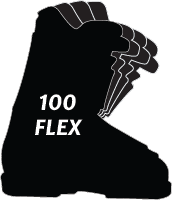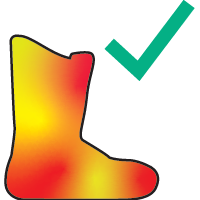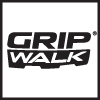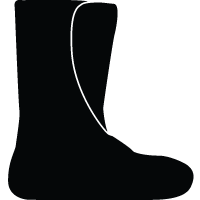spécifications du produit
Condition:
 More Info
More Info
Condition

Well Loved - A well loved boot shows significant signs of wear and tear including heel wear, scratching, and scuffing on a majority of the boot’s surface area.
Fair - A fair boot shows some signs of wear and tear on the sole of the boot. This includes chipping, scratching and scuffing on high impact areas like the heel and toe lugs. The liners in these boots are typically very broken in.
Good - A good boot shows minor signs of wear and tear with little heel and toe wear, some minor cosmetic scratches across both boots, but no major damage. Liners in these boots have been broken in but still have some life left in them.
Excellent - An excellent boot shows almost no signs of wear and tear on the sole or upper of the boot shell. The liners in these boots show little signs of break in and will fit tighter than a boot that has been used more.
Flex:
 More Info
More Info
Flex

The flex of a ski boot is the measure of force required to bend the boot at the ankle. The stiffer the boot is, the more support it provides. A stiffer boot requires the skier to stand with their weight further forward in order to transfer energy through the boot to the ski effectively. Softer, more forgiving boots are meant for less experienced or lighter skiers. A softer boot requires less energy to initiate the turn of the ski.
Ski boot flex ranges from about 40 (for small children) up to 130 for general consumer boots. An 85 flex is generally a medium stiffness for intermediate women skiers, and a 100 flex is a generally a medium stiffness for intermediate men. Some race boots, categorized as “world cup flex” are measured at 140-170 flex and are built for only the most aggressive skiers. Ultimately, the flex index is not a perfectly succinct measurement across boot brands; it is always best to try a boot on before buying to confirm the flex works well for you.
Last:
100Last

The last of a ski boot is essentially the width measurement of the boot shell at the forefoot. The last is also a general indication of the volume inside the boot shell; a wider last increases the boot’s overall volume. A boot with a narrow last is generally measured at 97mm or 98mm wide. A medium last measurement is about 99mm - 101mm, and a wide last is any measurement 102mm or greater.
Moldable Liner:
Yes More Info
More Info
Moldable Liner

In recent years, many manufacturers have started building liners that can be custom molded to the skier’s foot using a specialized oven. The liner is heated to soften the inner foam and inserted into the boot shell. The skier then inserts their foot, tightens the buckles and stands in the boots while the liners cool and form to their feet. A heat moldable liner allows for greater fit customization for the skier and ultimately more comfort.
**The liner molding process should always be performed by a qualified boot-fitter with the proper tools. Trying this at home could damage your liners. **
Moldable Shell:
Yes More Info
More Info
Moldable Shell

Some manufacturers have introduced a heat moldable boot shell. Similar to a heat moldable liner, these shells are placed in a specialized oven and heated to soften the plastic of the shell. The boot is then placed on the skier’s foot and allowed to cool and form to the skier’s feet. A heat moldable shell offers the ultimate customization for the entire foot rather than traditional boot fitting techniques like punching or grinding.
**The shell molding process should always be performed by a qualified boot-fitter with the proper tools. Trying this at home could damage your boots.**
Sole Type:
 More Info
More Info
Sole Type

Alpine ISO 5355 - The most common sole type for inbounds skiing, the Alpine ISO 5355 norm is the traditional flat sole style with hard plastic where the boot contacts the binding. Boots with an Alpine ISO 5355 sole are compatible with Alpine, MNC, WTR and GripWalk certified bindings.

GripWalk - GripWalk has become an industry standard sole type over recent years and is often found in alpine specific boots and some hybrid inbound/touring boots containing tech toe and heel fittings. Originally introduced to provide a more natural walking feeling, GripWalk soles feature a more rockered profile. GripWalk boots are compatible with GripWalk certified bindings along with MNC, WTR and touring bindings (provided the boot has tech fittings).

Touring ISO 9523 - The Touring ISO 9523 sole type has tech fittings in both the toe and heel of the boot and a rockered rubber sole for more natural walking. Some Touring ISO 9523 boot soles feature an anti friction device plate that aids in release, but others do not. Boots in this category are compatible with ISO Certified touring bindings and MNC bindings.

Non ISO-Certified - Non ISO-Certified touring boots are built outside the standard norm for Touring ISO 9523, but are compatible with the universal tech (pin) bindings. These boots are only compatible with bindings certified for non compliant touring boots.
Liner Type:
Tongue More Info
More Info
Liner Type

Tongue - The tongue style liner is the classic liner construction found in most ski boots. Tongue liners are often thinner than wrap style liners but offer a better fit for those with a higher instep.

Wrap - Wrap liners are less common than tongue liners and are often found in a 3 piece style boot like the Dalbello Krypton/Lupo line or any Full Tilt boot. Wrap liners generally take up more volume in the boot shell, and are better suited for skiers with skinnier legs/calves.
Tech Toe Compatible:
YesTech Toe Compatible

Modern touring bindings have been engineered to attach differently than a traditional alpine binding. The “Tech” style binding uses pins that fit into specific inserts in the sides of the boot’s toe and into the back of the boot’s heel. These special inserts are built into the boot and are necessary to utilize a tech style touring binding.
Walk Mode:
Yes More Info
More Info
Walk Mode

Walk modes are generally found on all touring boots and some inbounds alpine boots. Walk mode can be advantageous to both a resort skier looking for comfort and a backcountry skier looking for increased range of motion and efficiency when skinning uphill. A walk mode device allows the user to free the cuff of the boot to flex both forward and backward, allowing for a more natural stride.
Buckle Adjustability:
YesBuckle Adjustability

Most modern boots have buckles with micro-adjustability features built in. Buckles screw in and out to lengthen or shorten the reach. This feature is useful when you need a bit more tightness but don’t need to go to the next ring on the buckle.
2023 Atomic Hawx Prime XTD 110 CT GW
spécifications du produit
Condition:
 More Info
More Info
Condition

Well Loved - A well loved boot shows significant signs of wear and tear including heel wear, scratching, and scuffing on a majority of the boot’s surface area.
Fair - A fair boot shows some signs of wear and tear on the sole of the boot. This includes chipping, scratching and scuffing on high impact areas like the heel and toe lugs. The liners in these boots are typically very broken in.
Good - A good boot shows minor signs of wear and tear with little heel and toe wear, some minor cosmetic scratches across both boots, but no major damage. Liners in these boots have been broken in but still have some life left in them.
Excellent - An excellent boot shows almost no signs of wear and tear on the sole or upper of the boot shell. The liners in these boots show little signs of break in and will fit tighter than a boot that has been used more.
Flex:
 More Info
More Info
Flex

The flex of a ski boot is the measure of force required to bend the boot at the ankle. The stiffer the boot is, the more support it provides. A stiffer boot requires the skier to stand with their weight further forward in order to transfer energy through the boot to the ski effectively. Softer, more forgiving boots are meant for less experienced or lighter skiers. A softer boot requires less energy to initiate the turn of the ski.
Ski boot flex ranges from about 40 (for small children) up to 130 for general consumer boots. An 85 flex is generally a medium stiffness for intermediate women skiers, and a 100 flex is a generally a medium stiffness for intermediate men. Some race boots, categorized as “world cup flex” are measured at 140-170 flex and are built for only the most aggressive skiers. Ultimately, the flex index is not a perfectly succinct measurement across boot brands; it is always best to try a boot on before buying to confirm the flex works well for you.
Last:
100Last

The last of a ski boot is essentially the width measurement of the boot shell at the forefoot. The last is also a general indication of the volume inside the boot shell; a wider last increases the boot’s overall volume. A boot with a narrow last is generally measured at 97mm or 98mm wide. A medium last measurement is about 99mm - 101mm, and a wide last is any measurement 102mm or greater.
Moldable Liner:
Yes More Info
More Info
Moldable Liner

In recent years, many manufacturers have started building liners that can be custom molded to the skier’s foot using a specialized oven. The liner is heated to soften the inner foam and inserted into the boot shell. The skier then inserts their foot, tightens the buckles and stands in the boots while the liners cool and form to their feet. A heat moldable liner allows for greater fit customization for the skier and ultimately more comfort.
**The liner molding process should always be performed by a qualified boot-fitter with the proper tools. Trying this at home could damage your liners. **
Moldable Shell:
Yes More Info
More Info
Moldable Shell

Some manufacturers have introduced a heat moldable boot shell. Similar to a heat moldable liner, these shells are placed in a specialized oven and heated to soften the plastic of the shell. The boot is then placed on the skier’s foot and allowed to cool and form to the skier’s feet. A heat moldable shell offers the ultimate customization for the entire foot rather than traditional boot fitting techniques like punching or grinding.
**The shell molding process should always be performed by a qualified boot-fitter with the proper tools. Trying this at home could damage your boots.**
Sole Type:
 More Info
More Info
Sole Type

Alpine ISO 5355 - The most common sole type for inbounds skiing, the Alpine ISO 5355 norm is the traditional flat sole style with hard plastic where the boot contacts the binding. Boots with an Alpine ISO 5355 sole are compatible with Alpine, MNC, WTR and GripWalk certified bindings.

GripWalk - GripWalk has become an industry standard sole type over recent years and is often found in alpine specific boots and some hybrid inbound/touring boots containing tech toe and heel fittings. Originally introduced to provide a more natural walking feeling, GripWalk soles feature a more rockered profile. GripWalk boots are compatible with GripWalk certified bindings along with MNC, WTR and touring bindings (provided the boot has tech fittings).

Touring ISO 9523 - The Touring ISO 9523 sole type has tech fittings in both the toe and heel of the boot and a rockered rubber sole for more natural walking. Some Touring ISO 9523 boot soles feature an anti friction device plate that aids in release, but others do not. Boots in this category are compatible with ISO Certified touring bindings and MNC bindings.

Non ISO-Certified - Non ISO-Certified touring boots are built outside the standard norm for Touring ISO 9523, but are compatible with the universal tech (pin) bindings. These boots are only compatible with bindings certified for non compliant touring boots.
Liner Type:
Tongue More Info
More Info
Liner Type

Tongue - The tongue style liner is the classic liner construction found in most ski boots. Tongue liners are often thinner than wrap style liners but offer a better fit for those with a higher instep.

Wrap - Wrap liners are less common than tongue liners and are often found in a 3 piece style boot like the Dalbello Krypton/Lupo line or any Full Tilt boot. Wrap liners generally take up more volume in the boot shell, and are better suited for skiers with skinnier legs/calves.
Tech Toe Compatible:
YesTech Toe Compatible

Modern touring bindings have been engineered to attach differently than a traditional alpine binding. The “Tech” style binding uses pins that fit into specific inserts in the sides of the boot’s toe and into the back of the boot’s heel. These special inserts are built into the boot and are necessary to utilize a tech style touring binding.
Walk Mode:
Yes More Info
More Info
Walk Mode

Walk modes are generally found on all touring boots and some inbounds alpine boots. Walk mode can be advantageous to both a resort skier looking for comfort and a backcountry skier looking for increased range of motion and efficiency when skinning uphill. A walk mode device allows the user to free the cuff of the boot to flex both forward and backward, allowing for a more natural stride.
Buckle Adjustability:
YesBuckle Adjustability

Most modern boots have buckles with micro-adjustability features built in. Buckles screw in and out to lengthen or shorten the reach. This feature is useful when you need a bit more tightness but don’t need to go to the next ring on the buckle.


